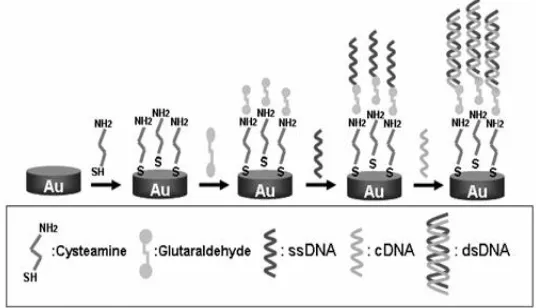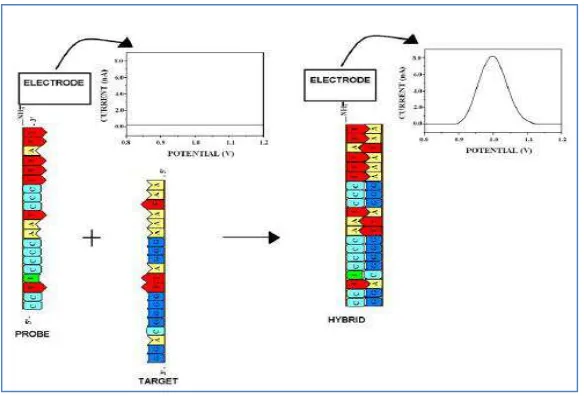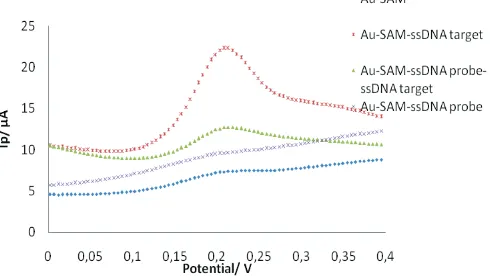Procedia Chemistry 17 ( 2015 ) 111 – 117
1876-6196 © 2015 The Authors. Published by Elsevier B.V. This is an open access article under the CC BY-NC-ND license (http://creativecommons.org/licenses/by-nc-nd/4.0/).
ScienceDirect
* Corresponding author. +62812-2132-349. E-mail address: [email protected]
3
rdInternational Seminar on Chemistry 2014
Label-Free Electrochemical DNA Biosensor
for the Detection of
Mycobacterium tuberculosis
using Gold
Electrode Modified by Self-Assembled Monolayer of Thiol
Ratna Nurmalasari, Yohan, Shabarni Gaffar, Yeni W. Hartati*
Department of Chemistry, Faculty of Mathematics and Natural Sciences,
Universitas Padjadjaran, Jl. Raya Bandung-Sumedang Km 21, Jatinangor 45363, Sumedang, West Java, Indonesia
Abstract
Tuberculosis (TB), an infectious disease affects millions of humans worldwide and is caused by the Mycobacterium tuberculosis. A label free electrochemical DNA biosensor for the detection of M. tuberculosis using gold electrode modified by self-assembled monolayer of thiol is presented in this paper. Single-stranded DNA probe was immobilized on the surface of self-assembled monolayer gold electrode with the assistance of cysteamine and glutaraldehyde, which was further used to hybridize with the target sequence and non-complementary target sequence. Differential Pulse Voltammetry (DPV) was used to characterize the self-assembled monolayer on the gold electrode and also to study the immobilization of ssDNA probe and hybridization with the complementary sequence (target ssDNA). The hybridization reaction on the gold electrode surface was detected by monitoring a guanine oxidation signal at potential +0.21 V. Electrochemical DNA biosensor using gold electrode modified of thiol (Au-SAM) can be used to determine hybridization between ssDNA probe and ssDNA target sequence of M. tuberculosis with sensitvity value is 0.5152; detection limit is 3.47 µg.mL-1 and quantification limit is 11.56 µg.mL-1
Keywords: DNA Biosensor, gold electrode, Self-Assembled Monolayer, Mycobacterium tuberculosis, guanine oxidation
1. Introduction
and control the disease2.
Many diagnosis for the detection of TB infection has been carried out by conventional methods such as acid fast staining (Ziehl-Neelsen), culturing on Lowenstein-Jensen media, and also the molecular assays such as Real Time PCR (RT-PCR) and Enzyme Linked Immunospot (ELISpot)2. The conventional methods are time consuming and insensitive1, (mycobacterium culture usually require 4 to 8 weeks to obtain good growth3. Some other molecular methods, such as latex agglutination, Enzyme Linked Immunosorbent assay (ELISA), radiometric detection and gen-probe amplified M. tuberculosis direct test (AMTDT), are more sensitive and rapid than conventional methods, however most of these methods are centralized in large stationary laboratories because complex instrumentation and highly qualified technical staff are required4.
Electrochemical DNA biosensor has aroused great interest in recent years for its simplicity, higher sensitivity and cheaper equipment. Electrochemical transducers are powerful tools for the detection of DNA hybridization reaction5. DNA biosensors are made by immobilizing single stranded (ss) DNA probes on different transducers for measuring the hybridization between the DNA probes and their complementary DNA strands. The immobilization of DNA probe onto the transducer plays an important role in the performance of the DNA Biosensor6.
Different methods have been used to immobilize the DNA onto electrode surface. Silva et al. (2010)7 had been using self assembled monolayer (SAM) by the assistance of cysteamine (cys) and glutaraldehyde (glu) to immobilized DNA probe on surface of gold electrode and used cyclic voltammetry to characterize SAM on the gold electrode. Silva et al. (2010)7 reported SAM is a good strategy for linking biomolecules, because this technique allows an easy formations of monolayers, reasonable stability for extended period, allowing several reliable measurements. However, SAM also presents limitations, such as, immobilization of enzymes are very much sensitive towards changes in analytical parameters (pH, temperature), a minor change in one of these parameters can sometimes be responsible for losing the biological activity7. The hybridization can be exhibited via the redox signal of an electrochemical indicator, which can be an organic molecules, metal complexes, enzymes, redox labels or nanoparticles5 or using techique direct oxidation8.
Issa et al., (2010)9 had been used electrochemical DNA biosensor using methylene blue on Screen Printed Carbon Electrode (SPCE) for the detection of M. Tuberculosis9. Hamdan et al. (2012)2 was developed electrochemical biosensor for the alternative detection of M. tuberculosis using Pencil Graphite Electrode (PGE) and methylene blue as electroactive intercalator2.
Here we report the used of label-free electrochemical DNA biosensor using gold electrode modified by SAM to study oxidation signal of guanine in various concentration of DNA M. tuberculosis target and to determined the specity of DNA probe. Differential Pulse Voltammetry (DPV) was used to characterize SAM on the gold electrode and also to study the immobilization of ssDNA probe and hybridization with the complementary sequence (target ssDNA)
2. Materials and Methods
2.1.Materials
2.1.1 Apparatus
Differential pulse voltammetry was carried out using potensiostat Metrohm® µAutolab type III connected to PC with NOVA software. Three electrode syestem were used consisted of an Ag/AgCl as reference electrode, platinum electrode as an auxiliary electrode and gold electrode (0.5 mm) as working electrode.
2.1.2. Chemicals
2.2.Methods
2.2.1.Pretreatment of the gold electrode7.
The gold electrode was mechanically polished with alumina slurry followed by rinsing with distilled water and sonication in pure ethanol and water (1:1), for 2 minutes. After mechanical cleaning, the gold electrode suffered a chemical treatment by immersion in a ‘piranha solutionÿ (H2SO4/H2O2, 1 : 3 v/v) for 10 minutes at room
temperature. Afterwards, the gold electrode was immersed in phosphate buffer (PB) and 10 cycles were carried out between + 02 and + 15 V at 50 mV s
–1
. Finally, the electrode was rinsed thoroughly with distilled water for 10 minutes and after exposed to UV radiation for 15 minutes.
2.2.2.Self-assembled monolayer and ssDNA immobilization7
The pretreated electrodes were immersed into 25 mmol L–1 ethanolic solution of Cys for 2 hours at room temperature (25o C). After that, the electrode was washed with distilled water and incubated in a Glu solution (25% of Glu in 01 mol L
–1
PB pH 70 at 4
o
C for 50 minutes). The Au-SAM electrode was then exhaustively washed with ultrapure water and incubated with ssDNA probe. The Au-SAM-ssDNA probe was incubated for 1 hour at room temperature (25 oC). Then, the electrode was washed for 2 minutes twice with PB (pH 70) to remove
the non-binding ssDNA probe. The immobilization of ssDNA on Au-SAM was scanned by differential pulse voltammetry in PB buffer solution7.
2.2.3.DNA hybridization
The probe-modified electrode was incubated with a solution containing complementary or non-complementary DNA sequence to the ssDNA probe for 30 minutes to form a hybrid double stranded DNA (dsDNA). After that, the modified gold electrode was washed with PB (pH 7.0) to remove the non-hybridized DNA probes, and then scanned by differential pulse voltammetry in PB buffer solution. A scheme of immobilization and hybridization is shown in Figure 1.
Fig. 1. Formation of the thiol-based monolayer on gold surface for DNA immobilization and hybridization. ssDNA = single stranded DNA, cDNA = complementary DNA, dsDNA = double stranded DNA.
3.Results and Discussion
3.1.Pretreatment of the gold electrode
uncontaminated gold surface is important for the good chemisorption of thiol group on gold. The use of self-assembled monolayer allows a connection between thiol group on gold and DNA probe which bind to an aldehyde ligand. Target DNA (cDNA) than will hybridized to probe DNA resulted in the possibility to determined DNA hybridization by guanine oxidation signals (Figure 1).
Modification of electrode can be done in two ways: (i) adsorption of thiols on gold surface followed by the adsorption of specific receptor on thiols monolayer (embedment procedure), or (ii) adsorption of functionalized thiols on gold surface, where thiols play as receptor. In both cases, the performances of modifications are dependent on the gold surface quality. If the gold surface is the smooth-faced one, its cover degree is higher, the obtained monolayer is well ordered, and the electrodes have great analytical performances10.
3.2.Guanines oxidation signal
In direct label-free electrochemical detection, the hybridization events trigger a changes of an electrical signal. This detection technique was eliminate the need of additional indicator and detection steps. In direct label free, in situ detection can be accomplished by monitoring changes in the intrinsic redox activity of the nucleic acid target (Figure 2). Among the four nucleic acids bases, the Guanine base is most easily oxidized and is most suitable for such indicator-free hybridization detection. To omitted the Guanine signals in probe sequences, Guanines in the probe sequences were substituted by Inosine base which is complement to Cytosine and has low oxidation signal, therefore the oxidation signals only come from Guanine in target DNA sequences which hybridized to probe DNA11.
Fig. 2. Schematic characterization of label-free eletrochemical detection12.
Fig. 3. The differential pulse voltammograms of blank solution, ssDNA probe, ssDNA target, hybridization of ssDNA probe-ssDNA target on Au-SAM in 0.1 M PB solution pH 7.0. Scanning potential – 1.0 to +1.0 V. Scan rate 50 mV.s-1
3.3.Specifity of DNA probe
The specificity of DNA probe for M. tuberculosis detection by using Au-SAM biosensor was tested by analyze the oxidation signal of DNA probe- DNA target hybrid and DNA probe- DNA non complementary mixture on Au-SAM. The results shown in Figure 4.
Fig. 4. The DPV voltammograms of guanine signal using Au-SAM in 0,1 M PB solution pH 7,0. (a) Au-SAM (b) Au-SAM-ssDNA probe-non complementary DNA; (c) Au-SAM-ssDNA probe-complementary ssDNA. Scanning potential is -1.0 to +1.0 V and scan rate is 50 mV.s-1.
As shown of Figure 4, no peak current observed at +0.21 V for ssDNA-non complementary DNA, because
hybridization between ssDNA probe and ssDNA non complementary doesn’t occured. However, DNA probe-DNA target was hybridize through the formation of hydrogen bond between complementary bases (G with C and A with T) and oxidation signal of Guanine in hybrid dsDNA was detected at +0.21 V. Therefore, this electrochemical DNA biosensor has a good specifity for specific oligonucleotide sequences.
3.4.Calibration curve
6. The peak currents produced by each concentration is varied, and there is a linear relationship between increased of concentration against peak currents height. The higher concentration of ssDNA target will be produced increased in the peak currents.
Fig. 5. Calibration curve of peak current vs ssDNA target concentration. Calibration curve was obtain by using ssDNA target 0, 5, 10, 15, 20 µg.mL-1 using DPV on Au-SAM in PB buffer 0.1 M pH 7.0. Scanning potential -1.0 to +1.0 V and scan rate 50 mV.s-1 (n = 3).
As seen in the Figure 5., the signal was linear between 0 and 20 µg mL-1 with a correlation coeffecient of 0.986 for complementary ssDNA target. The regression equation was y = 0.489 x + 0.383. We have to calculate confidence interval for intercept (a) to test systematic errors in a measurement and for this measurement the 95% confidence interval for intercept is from -0.90359 to 1.67016, so that is indicate the value of intercept through the point of zero, so the regression equation had a adjusment to y = 0.5152 x. The detection limit and quantification limit values were calculated using fllowing equations: yLOD = yb + 3 Sb and yLOQ= yb + 10 Sb. The detection limit value is
3.47 µg.mL-1and quantification limit value is 11.56 µg.mL-1.
Fig. 6. The DPV voltammograms of Au-SAM-ssDNA-different concentration of ssDNA target in 0.1 M PB solution pH 7.0. Potential scanning – 1.0 to +1.0. Scan rate 50 mV.s-1.
Conclusions
Acknowledgements
This work was partially supported by Directore General of Higher Education, Ministry of Education and Culture, Indonesia with Excellent Research Program by YWH, 2013-2014.
References
1. Abdelwahab, A.E. Immonologocal and molecular diagnosis of mycobacterium tuberculosis between two enviromentally different regions. Acedemic Journal Inc 2009;1(1), 1-8.
2. Hamdan, N. A., R. Issa, M. F. M. Noh, N. M. Zin. Electrochemical techique using methylene blue with pencil graphite electrode for optimum detection of Mycobacecterium tuberculosis DNA. Curr. Res. Tuberculosis 2012;4: 1-12.
3. Mehdikani, S. H. and N. Rokni. Use of PCR method based on IS6110 for detection of Mycobacterium tuberculosis complex in cattle. World Applied Sciences Journal 2012;19(4): 504-509.
4. Zhou, L., X. He, D. He, K. Wang and D. Qin. Biosensing technologies for Mycobacterium tuberculosis detection: status and new development. Clinical and Development Immunology 2011;10: 1-8.
5. Gao, H.W., P. Qin, C. Lin, Z.M. Shang and W. Sun. Electrochemical DNA biosensor for detection of Listeria monocytogenes using toluidine blue as a hybridization indicator. J. Iran Chem 2010;7: 119-127.
6. Matur, N., A. Mahanderu, N. Brar and D. P. Katare. DNA based biosensors in disease diagnosis. World jurnl of pharmacy and pharamaceutical science 2012;2: 407-428.
7. Silva, M.M.S., I. T. Cavalanti, M. F. Barroso, M. G. F. Sales and R. F. Dutra.. Gold electrode modified by self-assembled monolayers of thiol to determine DNA sequences hybridization. Journal Chem Science 2010;122: 911-917.
8. Souza, E.L., G. Nascimento, N. Santana, D. Ferreira, M. Lima, E. Natividade, D. Martins and J.L. Filho.. Label-Free electrochemical detection of the specific oligonucleotide sequence of Dengue virus type 1 on pencil graphite electrodes. Sensors 2011;11: 5616-5629. 9. Issa, R., N. A. Hamdan and M. F. M. Noh. Differential Pulse Voltammetric Determination of DNA Hybridization Using Methylene Blue on
Screen Printed Carbon Electrode for The Detection of Mycobacterium tuberculosis. Biotechnology 2010;9: 304-311.
10. Bulgariu L. and D. Bulgariu. Self-assembled monolayer of thiols on gold electrodes prepared by electrochemical deposition on platinum wire. Chem Bull 2008;53: 163-167.
11. Wang, J. Review Electrochemical nucleic acid biosensors. Analytica Chimica Acta. Elsevier Science 2002;469: 63-71.


